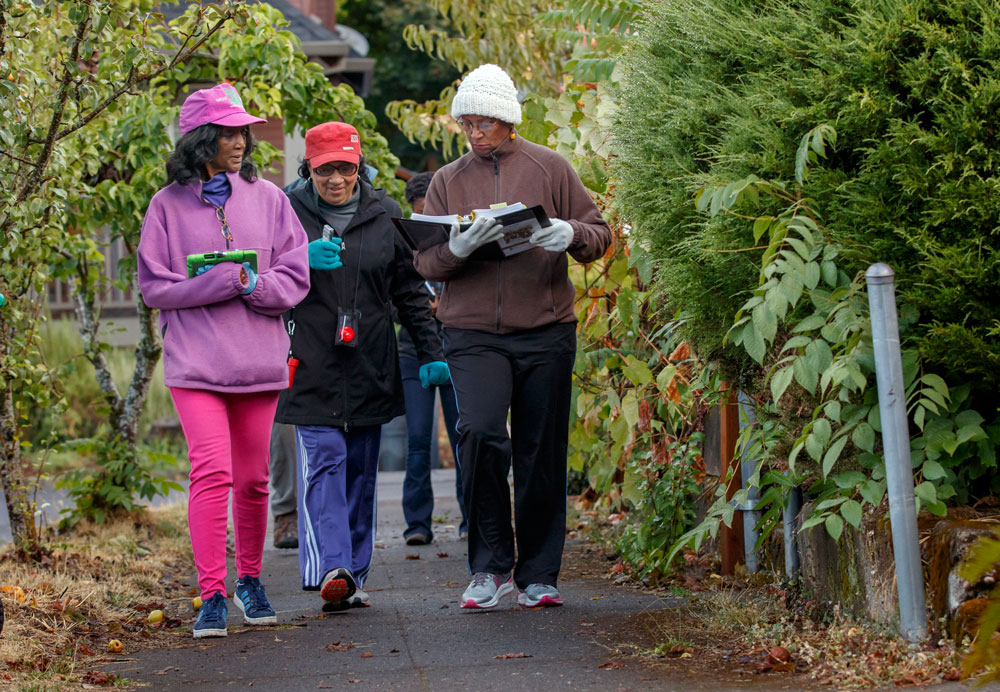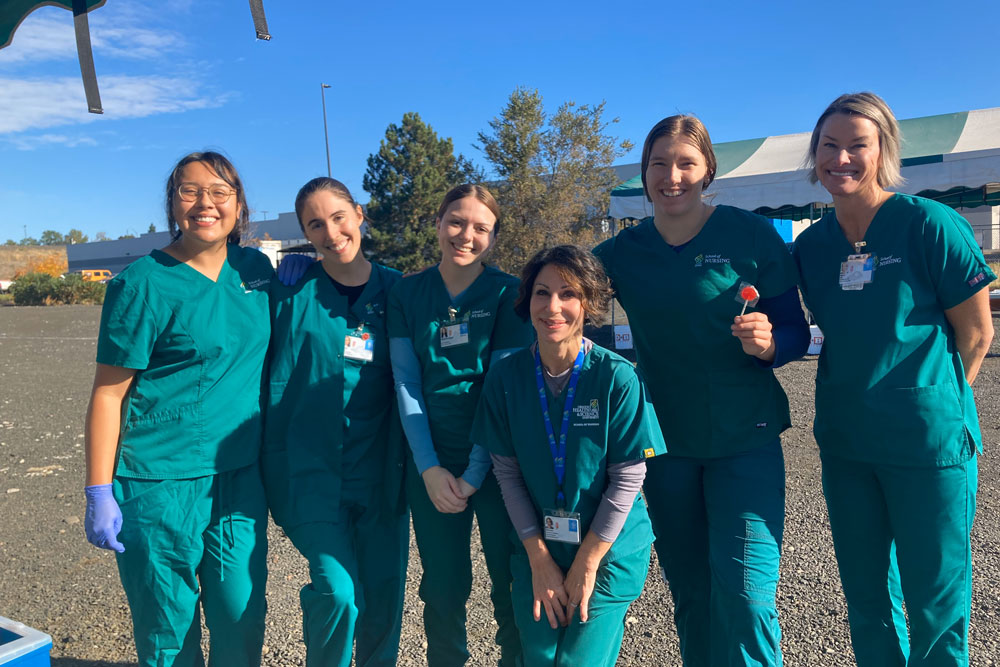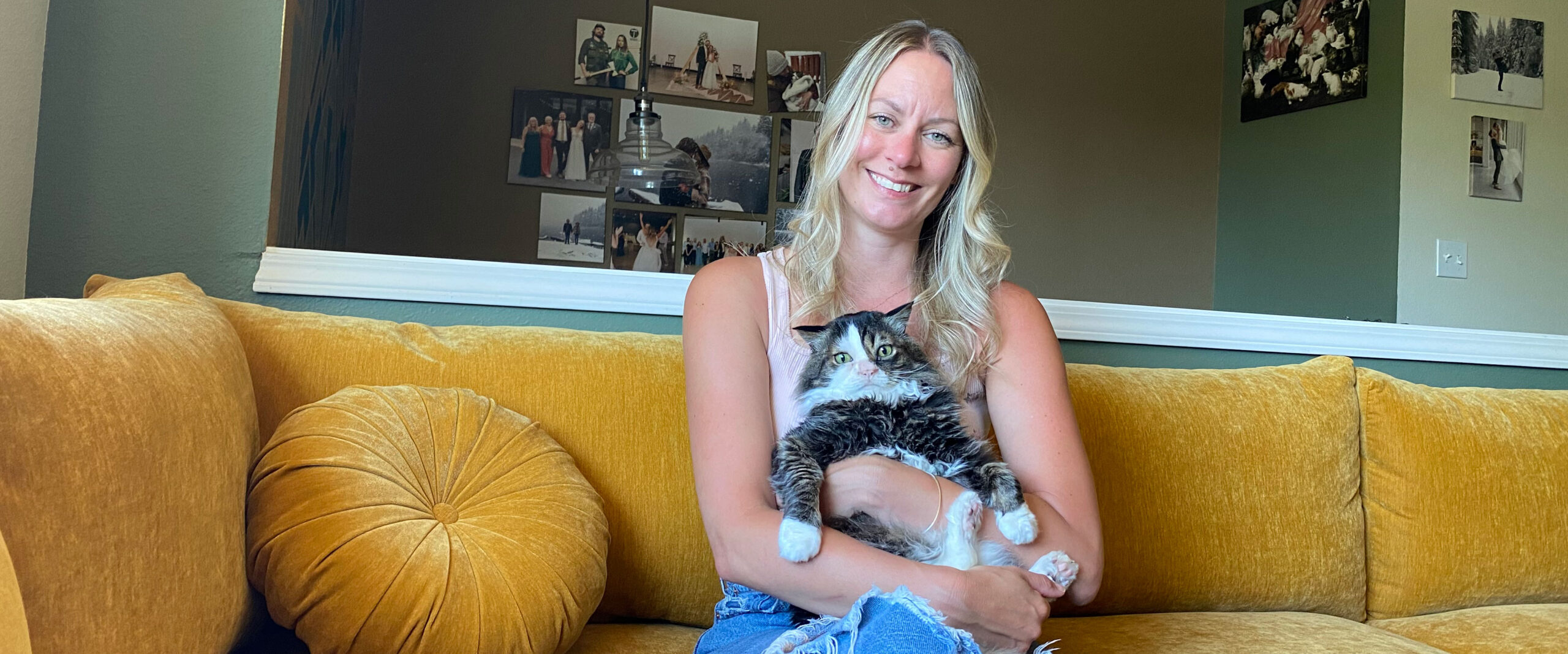By Josh Friesen
For Ignite Magazine
OHSU is a part of Oregon. Its impact spreads through every corner of the state — from the beaches of the Pacific coast and the rugged Cascade peaks to the bustling urban centers and windy grasslands of the Columbia Plateau. Through innovative collaborations and outreach efforts, OHSU works alongside communities to address barriers to care, promote health equity and meet people where they are.
Forging impactful partnerships with communities has always been vital to OHSU’s focus on advancing research, education and outreach to improve human health and well-being. This steadfast dedication continues to inspire connections and open new doors for community clinics, culture-centered research, innovative education initiatives and free health screenings. These collective efforts foster deeper connections between health care providers and the communities they serve, stretching OHSU’s missions of teaching, healing and discovery far beyond its walls.
The following stories highlight just a few of the ways OHSU is working to make a difference, painting a picture of an institution that isn’t just in the community, but a key part of it. Private philanthropy is a boon to these programs, partners and people, each of which demonstrates the depth of OHSU’s reach, impact and connection across all 96,000 square miles of Oregon.
Russell Street Dental Clinic
For half a century, the Russell Street Dental Clinic has been a Portland staple and an early model of community care.
The clinic was established in 1975 by David Rosenstein, D.M.D., M.P.H., then an associate professor in the OHSU School of Dentistry, to provide free, high-quality dental care to an older population and homeless, low-income and migrant worker communities. In the 1980s, the clinic became a haven for people who tested HIV-positive, many of whom were refused treatment elsewhere.

Today, the clinic, staffed by OHSU dental students and faculty and led by director Michele Pindyck, D.M.D., is both a place of care for community members and learning for students. The clinic sees 75 students on rotation every year and cares for approximately 1,200 patients. Fifty years after its founding, the clinic continues to honor Rosenstein’s mission to never turn away a patient — a mission that has gone a long way in maintaining the trust of the community.
“The emphasis of Russell Street is serving the underserved,” Pindyck said. “A lot of times, our patients are comfortable being at Russell Street as opposed to someplace else.”
Along with offering a variety of dental services, including fillings, root canals, crowns, dentures and extractions, the clinic also provides treatment for people with HIV. The Ryan White HIV/AIDS Program, a federal grant that provides HIV/AIDs treatment and services to people who are uninsured, began supporting the clinic in 1990.
“Our students are out in the community — at schools, at senior centers, at care facilities — engaging with the population and trying to get a sense for what the health care needs are. They really become connected to the people in those rural communities, and the rural communities love having the students.” – Patricia Barfield, Ph.D., RN, PMHNP-BC
Russell Street partners with the Multnomah County Health Department, the OHSU Partnership Project and the OHSU Division of Infectious Disease to coordinate treatment of new patients with HIV. The clinic also maintains collaborative relationships with local HIV organizations.
“We have the flexibility and the backing of OHSU to make sure we’re doing what’s right for the patient population,” Pindyck said. “And I feel patients really tend to feel that from us.”
HPV Self-Collection
In spring of 2024, the FDA granted approvals for two self- collection screening tests that detect human papillomavirus (HPV) in the cervix — a common sexually transmitted infection that can lead to cervical cancer.
Vanderlene Kung, M.D., Ph.D., an assistant professor of pathology and laboratory medicine in the OHSU School of Medicine, is partnering with community organizations to help spread the word and raise awareness about HPV and cervical cancer.

“We’re trying to supplement testing with education,” said Kung, who also directs DEI in the Department of Pathology and Laboratory Medicine. “What is cervical cancer? What is HPV virus, and what does it mean to have it? Why is testing important, and who needs it? It’s great to be able to be a resource and help answer those questions.”
HPV vaccination is a widely available way to provide safe and lasting protection against HPV and has been available since 2006. According to the CDC, the vaccine can prevent more than 90% of the cancers caused by HPV.
There are significant disparities, however, in HPV vaccination among low-income populations and within certain racial and ethnic groups.
“Cervical cancer screening used to require a sample from the cervix, which required people to go into a traditional doctor’s office and get a pelvic exam,” Kung said. “That’s invasive and time-consuming. For cultural or religious reasons or for people who’ve experienced trauma, [that exam] can be something they just don’t want to do. The approval of the self-collection led us to say, ‘We need to get this out to the populations who are under-screened.’”
Since that FDA approval, Kung has worked with local organizations such as the Chinese Friendship Association and Adelante Mujeres to coordinate classes and integrate education into existing community events.
“Encouraging vaccination in these communities is a huge part of the effort as well,” Kung said. “It’s a cancer that is preventable. We’ve got to use the tools we have to close the gap in cervical cancer.”
Novel Interventions in Children’s Health Care
Linda Martin Stanger introduces herself to patients and their families as their “second brain.”
Anything a patient or a caregiver might need — help scheduling appointments, connecting with community resources, navigating health insurance, securing transportation or even just lending a listening ear — Stanger is there.
Stanger serves the Coos and Curry counties region as an interventionist for Novel Interventions in Children’s Healthcare (NICH), a program housed within OHSU Doernbecher Children’s Hospital that supports and advocates for families of pediatric patients with complex or chronic health conditions. Interventionists, who are embedded in communities across Oregon, are the do-it-all resource and liaison between patient-families and the health care system. NICH was able to expand into the Coos and Curry county region in 2022 thanks to more than $200,000 in grant funding from the Judith Ann Mogan Foundation.
The families NICH supports are often navigating other significant social challenges, including homelessness, food insecurity, language/cultural barriers and transportation issues. Interventionists collaborate with local organizations to help connect families to resources outside of health care.
“If you have a child who has a complex or chronic medical condition and who also carries significant social burden, there is no infrastructure,” said NICH co-founder Michael Harris, Ph.D., a professor of pediatrics in the Institute on Development and Disability at OHSU and Doernbecher Children’s Hospital. “The medical system looks to the community for answers, while the community looks to the medical system for answers. That’s where the NICH magic happens, bridging the medical system with the community in supporting our most vulnerable youth.”

NICH interventionists work with families to empower them to learn not only how to navigate their child’s care on their own, but how to navigate other resources at their disposal.
“A lot of times, families don’t know what they don’t know,” Stanger said. “Navigating the health care system is a big challenge. We can help point them to resources and help them learn those mechanisms to advocate for themselves.”
The NICH program has proven successful at easing burdens on patient-families and improving access to medical care while overall reducing health care costs for the system. In one example, Harris mentioned a teenager living with Type 1 diabetes who’d been admitted to OHSU 22 times in one year. After NICH intervention, the patient’s blood sugar levels improved to the point where they no longer needed hospitalization.
Initial support from The Leona M. and Harry B. Helmsley Charitable Trust helped disseminate the NICH model at two other children’s hospitals: the Lucille Packard Children’s Hospital at Stanford University and Benioff Children’s Hospitals at the University of California, San Francisco.
“A really important part of the interventionists’ position is to collaborate with community resources and assist families in obtaining those resources, because we ultimately want to keep those families in their communities,” Harris said.
The SHARP Study
Innovation is sometimes inspired by a simple change of perspective.
For Raina Croff, Ph.D., that perspective sits at the intersection of anthropology and neurology. The innovation is the SHARP study.
“I’m an anthropologist who didn’t go to medical school, didn’t get an M.P.H.,” said Croff, an associate professor of neurology in the OHSU School of Medicine and the Oregon Alzheimer’s Disease Research Center. “Coming to OHSU, I had a different perspective than most. I centered culture, people’s values and their approaches to life.”

Croff’s program, SHARP, or Sharing History through Active Reminiscence and Photo-Imagery, combines the benefits of exercise and communal relationships with historical reflection. The study enlists older Black adults to walk predesignated routes through historically Black neighborhoods in Portland — neighborhoods that have since undergone drastic changes through gentrification. During the mile-long walks, participants are prompted to reflect with one another on the history of their location through old photos, newspaper clippings and advertisements.
The study was established to examine ways to maintain and improve cognitive health in a culturally celebratory way. Participants demonstrate measured improvements in mood, health and memory retention. Recent findings also showed improvements in participants who began the study with mild memory loss, indicating the potential for benefits among those affected by Alzheimer’s disease.
Establishing community relationships has been pivotal to SHARP’s success. Croff developed focus groups in tandem with the Urban League of Portland and PreSERVE Coalition for African American Memory and Brain Health, collaborations that have provided data to supplement SHARP’s findings.
The SHARP study is expanding outside of Portland, with routes being established in communities in Seattle and Oakland. Croff is also coordinating with a local theater company to turn participants’ conversations into onstage productions.
“If you want to do community work, you need to be part of the community. You need to show the community you’re interested in the long haul,” Croff said. “To do that, you need to be connected with community groups.”
Three Sisters Rural Track Program
In June 2024, three OHSU residents became the inaugural class of the Three Sisters Rural Track Program (RTP), a collaboration between OHSU and the St. Charles Health System in Madras, Oregon. The program is Central Oregon’s first graduate medical education program and is aimed toward increasing health care access and meeting the needs of rural Oregonians.
“Having those learners here just adds a new dynamic to the level of care we’re going to be able to provide,” said Jinnell Lewis, M.D., RTP, director and a family medicine physician at St. Charles. “By putting this program in a rural area where we know there’s a shortage of providers, over time, we’re going to build the number of providers that stay not only in this community but in other areas where there’s need.”

A 2025 Oregon State University report pointed to a lack of primary care providers in the state’s rural areas compared to urban areas. In 2024, the primary care capacity ratio was 1.16 in urban areas. In rural and remote areas, the ratio was 0.69. Data also shows that among residents who graduate from their program, about half stay within 100 miles of where they were trained. RTP, which was inspired by the Cascades East Family Medicine Residency Program in Klamath Falls, Oregon, aims to replenish health care providers in central Oregon by educating them in those communities. Fostering trust between rural health care centers and the community is vital to ensuring that transition.
“The trust between OHSU and those communities needs to be strong, otherwise that pathway doesn’t happen,” said Jessica Latham, program manager for RTP and manager of rural education and expansion at OHSU.
Jana Charl, RTP program coordinator, agrees, adding that developing a program influenced by the community it is a part of was crucial.
“Having a distinct residency with our own identity is important,” she said. “You see people you know in the community all the time because it’s small. We navigate the help we get from OHSU to build the program while also making it our own.”
RTP’s first cohort will spend its first year of the program receiving advanced medical training at OHSU’s Portland campus. They will spend the second and third years in the program at St. Charles in Madras.
“If you have students you’re teaching who someday might end up back in your community or working side by side with you, that’s a huge way OHSU integrates themselves into communities and creates that trust and partnership,” Lewis said.
The program’s launch was supported by the U.S Department of Health and Human Services’ Health Resources & Service Administration and a $1 million Healthy Oregon Workforce Training Opportunity grant. Donations to St. Charles Foundation will support ongoing training and recruitment efforts, technology upgrades and additional needs as the residency program grows.
Community Cancer Control Specialists
For Carina Garcia, Hermiston, Oregon, is home.
It’s where she grew up. She knows the community, the people, their values. Garcia’s connection to Hermiston, Umatilla County and eastern Oregon is invaluable to her role as a community cancer control specialist for the OHSU Knight Cancer Institute.
“My connections to people who serve in different community-based organizations or do different work with the Latino community here has been very important,” Garcia said. “It’s led me to be able to have opportunities to get our message out to this community.”

The Community Cancer Control Specialists program is part of Knight Community Outreach and Engagement. The four specialists in Oregon serve Eastern Oregon, the Columbia River Gorge region, the south Oregon coast and the Willamette Valley. Specialists establish partnerships between the Knight Cancer Institute and local community organizations to implement cancer prevention and education activities. Their efforts contribute to the implementation of the Oregon Comprehensive Cancer Control Plan, a strategy devised by the Oregon Health Authority with support from the Knight Cancer Institute that aims to better understand and address causes of cancer, improve screening rates for at-risk populations and implement evidence-based, culturally informed interventions.
One of the community organizations Garcia has connected with is the Pink Lemonade Project, a nonprofit that advocates for and empowers people in southwest Washington and Oregon impacted by breast cancer. With Garcia’s help, the Pink Lemonade Project has developed a community health worker training that focuses on the unique needs of rural Oregonians. Garcia has been able to parlay that connection into developing in-person community health trainings in collaboration with the Eastern Oregon Coordinated Care Organization.
More broadly, Garcia and the other specialists collaborate with schools, local health departments, providers and nonprofits to address their specific region’s cancer-related needs.
“There are a lot of organizations that serve this community. Hermiston is actually one of the few regions in Oregon where Latinos are likely to become the majority demographic in the future,” Garcia said. “It’s important to do outreach with this community and to be able to get information in their language.
Our connections to these organizations have been very important and have led to opportunities to get important health-related messaging out.”
Oregon Vision Health Network
The OHSU Casey Eye Institute has a long history of outreach with the goal of increasing access to high-quality vision care for every Oregonian.
In 2021, the institute leaned into the power of community with the establishment of the Oregon Vision Health Network (OVHN), a coordinated effort that weaves technology and community partnerships together. By training local community health workers as Vision Health Navigators and expanding telehealth outreach deeper into rural Oregon, the OVHN leverages the institute’s existing relationships to meet people where they are in the effort to eliminate preventable blindness in Oregon.
“We’ve done a great job at ensuring that our top priority is outreach,” said Dove Spector, research manager for the Casey Eye Institute’s community outreach program and program manager of telehealth expansion. “Because of Casey Eye’s long track record of community engagement, it’s made our efforts so much easier getting these services rolled out because relationships were already established.”

The Casey Eye Institute’s mobile outreach program has long been a point of excellence, providing vision screenings for thousands of people with limited or no access to vision care across nearly every one of Oregon’s 36 counties. But they knew they could do more. The screening is important, but engaging community partners to ensure effective follow-up care and identifying specific barriers to access are vital to completing a comprehensive standard of care.
“It was important to ensure the community partners we’re collaborating with have the tools and resources to facilitate efficient and effective follow-up care,” Spector said.
To address that gap, the Vision Health Navigator training was established through the Oregon Health Authority Office of Equity and Inclusion. OHSU trains local health care workers in helping patients who receive screenings take the next step — determining if they need glasses or if they might be developing sight-threatening diseases.
In addition, support from the Roundhouse Foundation and the Judith Ann Mogan Foundation is allowing the Oregon Vision Health Network to expand its telehealth capabilities. When telehealth sites in Coos Bay and Madras finish onboarding summer of 2025, there will be seven total.
“Not only the way we interact with partners, but the level of care we provide is outstanding,” Spector said. “I truly believe we give the highest quality care possible. When we are out in community, in addition to knowing we’re in the community’s space, we know we’re representing the Casey Eye Institute, and we take that to heart.”
OHSU School of Nursing, La Grande
The OHSU School of Nursing in La Grande has always taken a community-centered approach to its education mission.
Every fall, 32 nursing students enter the School of Nursing in La Grande’s program, completing their coursework on Eastern Oregon University’s campus. Their clinical rotations are administered through collaborations with 64 different clinical partners that span 11 counties in Oregon, Washington and Idaho. Upon completion of the three- year program, about 70% of graduates stay in the region.

Patricia Barfield, Ph.D., RN, PMHNP-BC, is one of the many dedicated and passionate people at the heart of it all. As campus associate dean for the School of Nursing in La Grande and regional associate dean for OHSU’s Campus for Rural Health in Northeast Oregon, Barfield oversees the development and delivery of the program. Her role allows her a front-row seat to the impact students have on the region through clinical rotations and volunteering opportunities — impacts that carry on after graduation.
“Our students are out in the community — at schools, at senior centers, at care facilities — engaging with the population and trying to get a sense for what the health care needs are,” Barfield said. “They really become connected to the people in those rural communities, and the rural communities love having the students.”
The health care needs of rural Oregonians are different from those in urban areas. Rural communities have higher rates of chronic disease, substance use disorders and mental health challenges but fewer resources to address them. Areas like eastern Oregon have fewer specialists and less advanced equipment, necessitating more providers with a wider scope of practice to best serve their patients. The La Grande nursing curriculum keeps this knowledge at its core, preparing its students to care for a wide range of patient needs.
“Our job is to prepare expert generalists that can step into a rural health system and take care of anybody who walks through that door,” Barfield said. “We work with and care for our family, friends and neighbors. Partnership and collaboration are how rural communities operate.”




